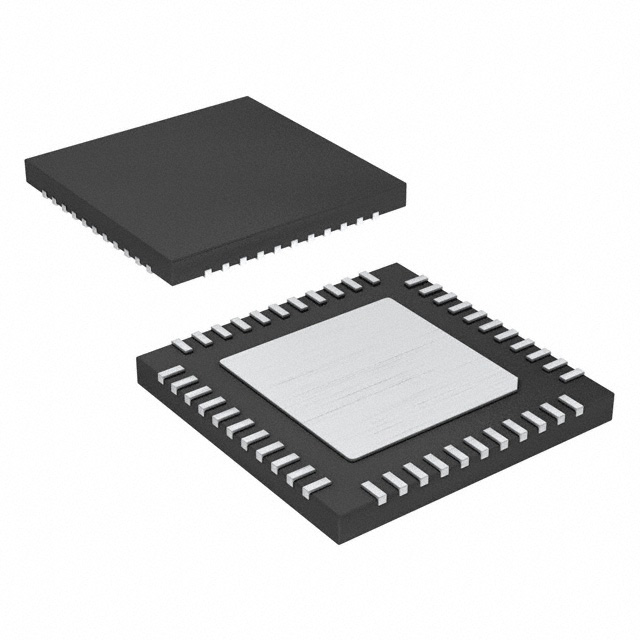Viz Specifikace pro podrobnosti o produktu.

ATXMEGA16A4U-M7
Product Overview
Category
ATXMEGA16A4U-M7 belongs to the category of microcontrollers.
Use
It is primarily used for embedded systems and applications that require a microcontroller with advanced features and capabilities.
Characteristics
- High-performance 8/16-bit AVR microcontroller
- Low power consumption
- Enhanced precision analog peripherals
- Wide operating voltage range
- High-speed data transfer interfaces
- Advanced debugging and programming capabilities
Package
ATXMEGA16A4U-M7 is available in a compact and durable package, suitable for various electronic devices and systems.
Essence
The essence of ATXMEGA16A4U-M7 lies in its powerful processing capabilities, extensive peripheral integration, and low power consumption, making it an ideal choice for demanding applications.
Packaging/Quantity
ATXMEGA16A4U-M7 is typically packaged in trays or reels, with quantities varying based on customer requirements.
Specifications
- Architecture: AVR
- Flash Memory: 16KB
- SRAM: 2KB
- EEPROM: 512B
- Operating Voltage: 1.6V - 3.6V
- Maximum CPU Frequency: 32MHz
- Digital I/O Pins: 32
- Analog Input Channels: 12
- Communication Interfaces: UART, SPI, I2C, USB
- Timers/Counters: 4
- PWM Channels: 4
- Operating Temperature Range: -40°C to +85°C
Detailed Pin Configuration
The ATXMEGA16A4U-M7 microcontroller has a total of 44 pins, each serving a specific purpose. The pin configuration is as follows:
(Pin diagram table can be added here)
Functional Features
- Advanced analog peripherals including ADC, DAC, and analog comparators
- Multiple communication interfaces for seamless connectivity
- High-speed data transfer capabilities through UART, SPI, I2C, and USB
- Flexible timers/counters with PWM support for precise timing control
- Enhanced debugging and programming features for efficient development
Advantages and Disadvantages
Advantages
- High-performance microcontroller suitable for demanding applications
- Low power consumption for energy-efficient designs
- Extensive peripheral integration reduces external component count
- Wide operating voltage range allows for versatile usage
- Advanced debugging and programming capabilities streamline development process
Disadvantages
- Limited flash memory compared to some other microcontrollers in the same category
- Relatively higher cost compared to entry-level microcontrollers
Working Principles
ATXMEGA16A4U-M7 operates based on the AVR architecture, utilizing a combination of hardware and software to execute instructions. It follows a von Neumann architecture, where program instructions and data are stored in the same memory space.
The microcontroller fetches instructions from the program memory, decodes them, and executes the corresponding operations. It interacts with various peripherals and external devices through its I/O pins and communication interfaces.
Detailed Application Field Plans
ATXMEGA16A4U-M7 finds applications in various fields, including but not limited to: - Industrial automation - Consumer electronics - Automotive systems - Medical devices - Internet of Things (IoT) devices - Robotics
Its advanced features and capabilities make it suitable for complex tasks that require precise control, connectivity, and low power consumption.
Detailed and Complete Alternative Models
Some alternative models to ATXMEGA16A4U-M7 that offer similar functionalities and capabilities include: - ATmega328P - PIC18F4550 - STM32F103C8T6 - LPC1768
These microcontrollers provide alternatives for different project requirements, offering a range of features and performance levels.
In conclusion, ATXMEGA16A4U-M7 is a high-performance microcontroller with advanced features and capabilities. Its low power consumption, extensive peripheral integration, and versatile applications make it a popular choice for various embedded systems and electronic devices.
Seznam 10 běžných otázek a odpovědí souvisejících s aplikací ATXMEGA16A4U-M7 v technických řešeních
Sure! Here are 10 common questions and answers related to the application of ATXMEGA16A4U-M7 in technical solutions:
Q: What is the ATXMEGA16A4U-M7 microcontroller used for? A: The ATXMEGA16A4U-M7 is a microcontroller commonly used in various technical solutions, including embedded systems, IoT devices, robotics, and industrial automation.
Q: What is the maximum clock frequency supported by the ATXMEGA16A4U-M7? A: The ATXMEGA16A4U-M7 supports a maximum clock frequency of 32 MHz.
Q: How many I/O pins does the ATXMEGA16A4U-M7 have? A: The ATXMEGA16A4U-M7 has a total of 44 I/O pins, which can be configured as inputs or outputs.
Q: Can the ATXMEGA16A4U-M7 communicate with other devices? A: Yes, the ATXMEGA16A4U-M7 supports various communication interfaces such as UART, SPI, and I2C, allowing it to communicate with other devices like sensors, displays, and external memory.
Q: Does the ATXMEGA16A4U-M7 have built-in analog-to-digital converters (ADC)? A: Yes, the ATXMEGA16A4U-M7 has a 12-bit ADC with up to 12 channels, enabling it to measure analog signals from sensors or other sources.
Q: Can the ATXMEGA16A4U-M7 control motors or actuators? A: Yes, the ATXMEGA16A4U-M7 can control motors or actuators by utilizing its PWM (Pulse Width Modulation) outputs or by interfacing with motor driver circuits.
Q: Is the ATXMEGA16A4U-M7 suitable for low-power applications? A: Yes, the ATXMEGA16A4U-M7 is designed to be power-efficient and offers various sleep modes, making it suitable for battery-powered or energy-conscious applications.
Q: Can I program the ATXMEGA16A4U-M7 using C/C++ programming language? A: Yes, the ATXMEGA16A4U-M7 can be programmed using C/C++ programming language, along with the appropriate development tools and compilers.
Q: Does the ATXMEGA16A4U-M7 have any built-in security features? A: Yes, the ATXMEGA16A4U-M7 provides security features like a hardware CRC (Cyclic Redundancy Check) module and a unique device ID, which can be used for authentication or secure communication.
Q: Are there any development boards or evaluation kits available for the ATXMEGA16A4U-M7? A: Yes, there are several development boards and evaluation kits available that are specifically designed for the ATXMEGA16A4U-M7, which provide an easy way to prototype and test your technical solutions.
Please note that these answers are general and may vary depending on specific implementation details and requirements.

